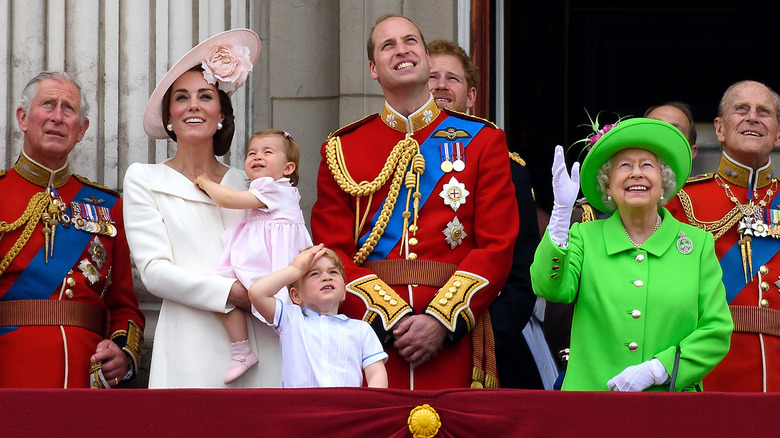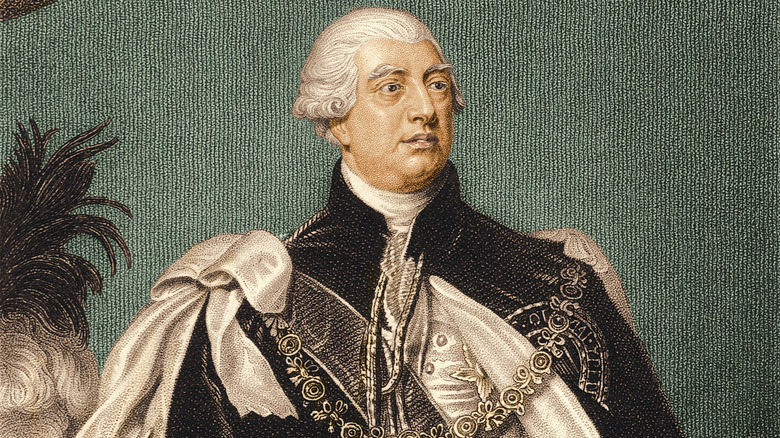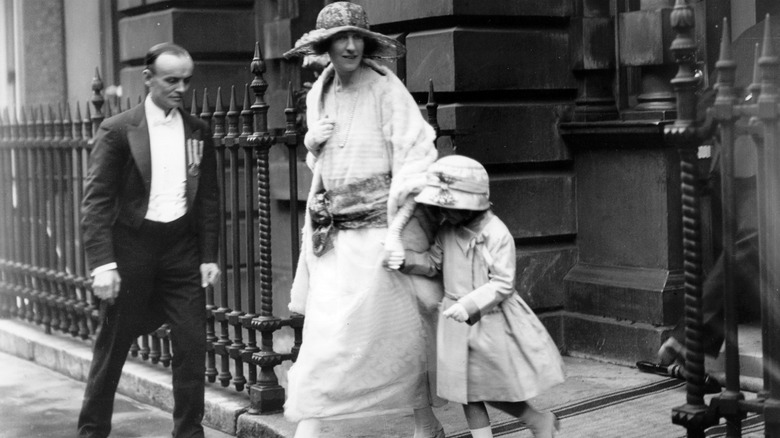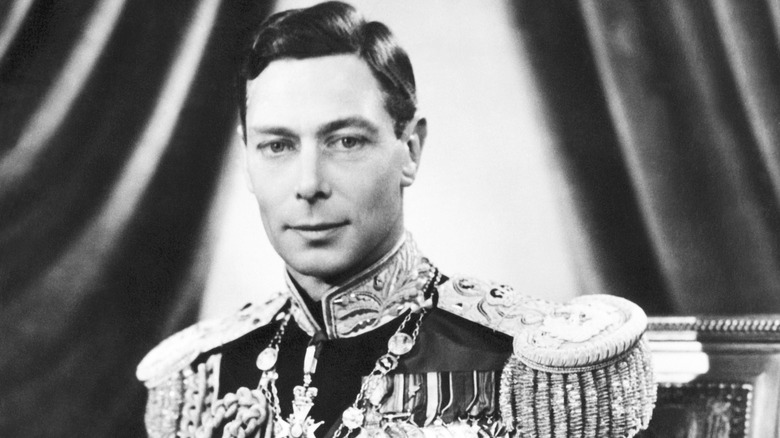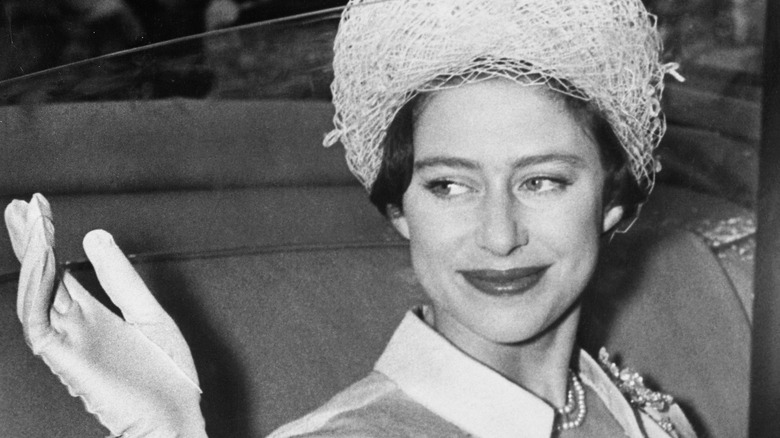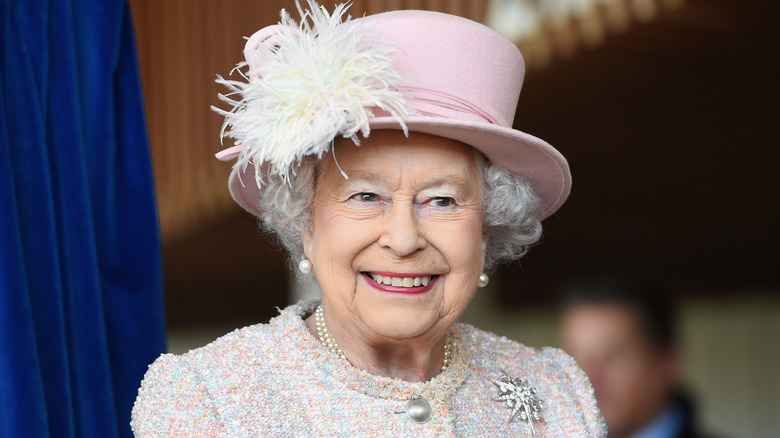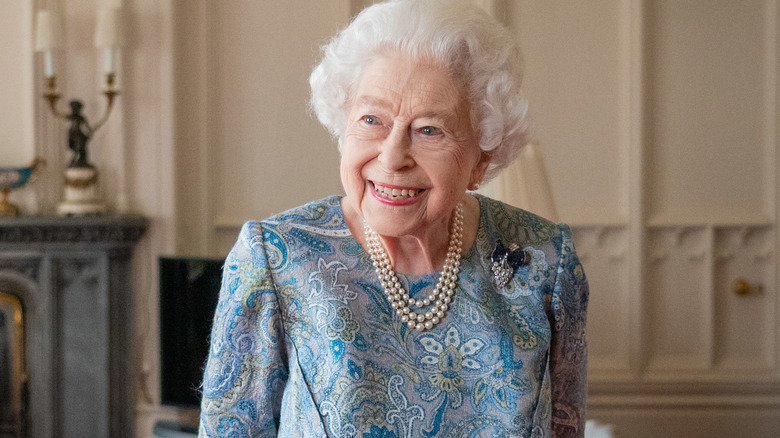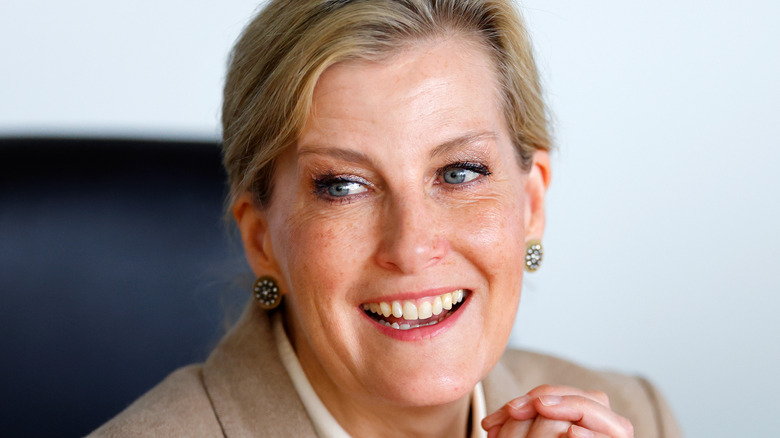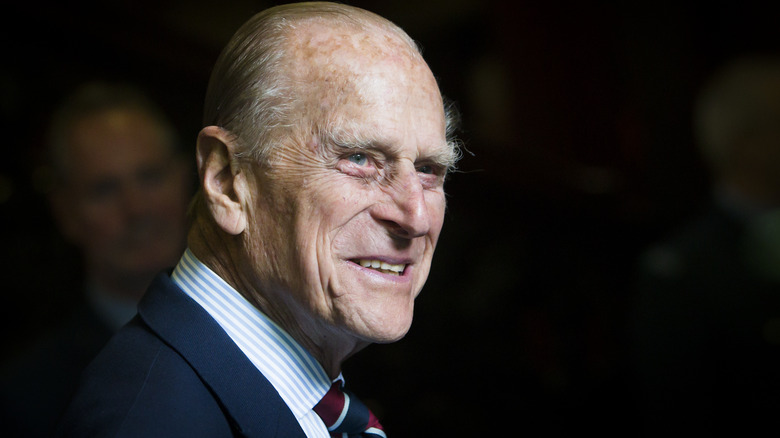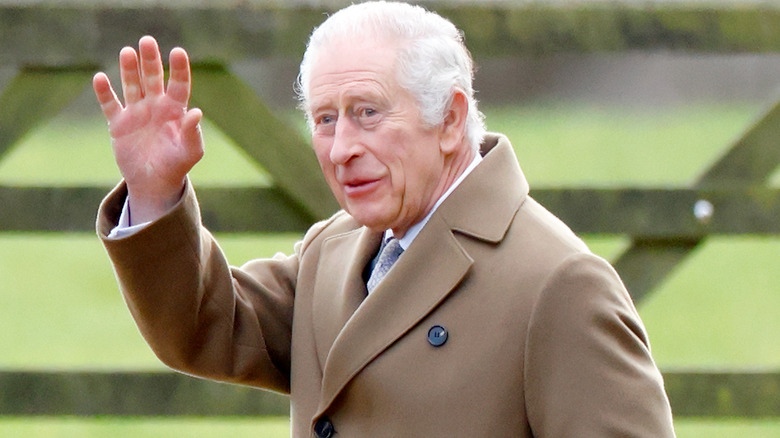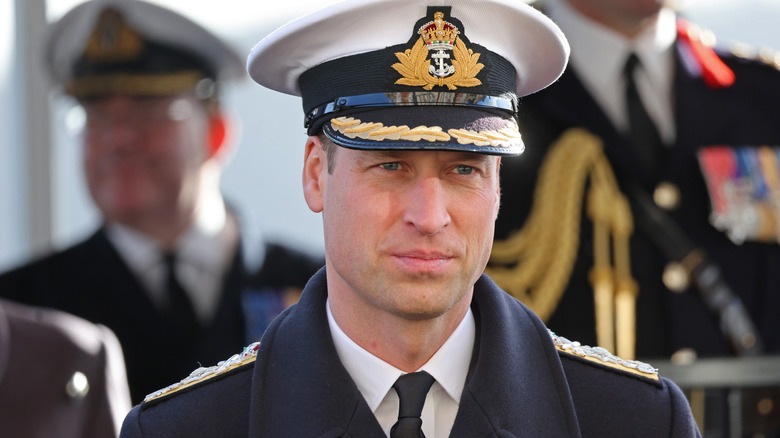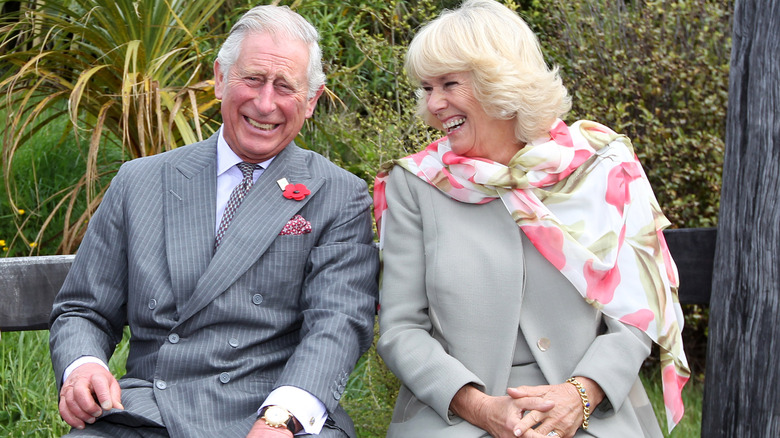Health Issues The Royal Family Tried To Hide
The following article mentions mental health issues.
The royals are back in the news, and for once, it's not because of family drama. Buckingham Palace told the public in January 2024 that Princess Catherine would be hospitalized for about 14 days for abdominal surgery. A couple of hours later, the palace revealed that King Charles III was set to undergo a corrective procedure for an enlarged prostate. In both instances, the public was assured that neither royal's condition was cancer-related. News outlets were baffled, tabloids had no idea what to do with the straightforward updates, and royal watchers gawked at the headlines, surprised that the news was not delivered to them via a tabloid's unnamed source. It seemed hard to believe, but the palace really did offer personal medical details to citizens without an ounce of pressure.
It's no stretch to say that when it comes to the family's health, the palace has a history of keeping a tight lid on it. During Queen Elizabeth II's reign, the monarchy went out of its way to keep the public from finding out about any health concerns the royal family was dealing with. It has been this way for centuries, and the public suddenly being informed about health issues without much fuss signals a significant change. Clearly, Charles plans to do things a little differently now that he is king. Their blood may be blue, but the members of the British royal family are still mortal.
King George III's ailing mental health couldn't be covered up
Though Buckingham Palace has gone to great lengths to keep royal family members' health issues relatively quiet, one could argue King George III's history of mental illness is what he's most remembered for. George III, for all he accomplished during his lifetime, is often referred to as "the mad king," and he's an example of a royal health crisis the palace simply couldn't cover up — no matter how hard it might've tried.
In 1765, King George III developed a fever. Around that time, he was said to have shown signs of cognitive decline. The king came down with the same illness in 1788, this time experiencing manic episodes and undergoing a complete personality change. For the next few decades, George III suffered multiple mental health-related struggles, and in 1810, his final episode began. In 1811, his son, King George IV, was appointed prince regent.
By the time he died in 1820, George III subjects knew about his illness, which was later said to have been caused by a hereditary blood disease called porphyria. Modern doctors and historians, however, theorize that the king had a mental illness like bipolar disorder.
Two of Queen Elizabeth II's cousins' deaths were faked to hide their disabilities
When Queen Elizabeth II's uncle on her mother's side, John Herbert Bowes-Lyon, and his wife, Fenella, welcomed two daughters with learning disabilities into the world, a grand coverup was staged to hide them from the public. The story sounds like something from a Hollywood movie script: After John died in 1930, Fenella was determined to keep her daughters' condition a secret to not endanger the image of the monarchy, so in 1941, she shipped Katherine and Nerissa off to the Royal Earlswood Hospital in London. To avoid any questions about their disappearance, Fenella went on public record and stated that her daughters had died.
Even the darkest secrets don't stay buried for long, however, and in 1987, The Sun published a devastating exposé about the two hidden cousins and how the royal family had conveniently forgotten about them. This sparked shock and outrage from the public, and Buckingham Palace scrambled to cover up the scandal, more or less pleading the fifth. "We have no comment about it at all. It is a matter for the Bowes-Lyon family," correspondence from the palace read (via The Independent). A 2011 documentary unearthed the scandal again; the palace claimed its contents were balderdash, but the testimony from a nurse who looked after the sisters put the royals in a pretty bad light. "The impression I had was that they'd been forgotten," she said.
King George IV's lung cancer was dubbed as a 'structural abnormality'
When Queen Elizabeth II's father, King George VI, was diagnosed with lung cancer, the public was kept completely in the dark — and so was the monarch. The former king first started experiencing symptoms in 1951, and an X-ray revealed a significant mass in his left lung. The king's doctors recommended the entire lung be removed, and he agreed to the operation. The public, however, was told that the monarch was undergoing a procedure to remove "structural abnormalities."
Doctors discovered that the mass was malignant, but instead of telling the king that he had lung cancer, they kept it quiet, effectively misleading the monarch and his subjects. Sir Clement Price Thomas, who performed the surgery, praised George's composure in a statement to the press. "The king is the best patient I ever had," he said (via Time).
A 2021 medical study published in Cardiovascular Pathology suggests that, by the time the king's lung was removed, the cancer was no longer concentrated in just that area but had already made its way into the right lung. The king, unaware of his fate, made what appeared to be a full recovery after the surgery. With the monarch and his subjects thinking he was as fit as a fiddle, his sudden death in 1952 was all the more shocking. Medical experts now believe that he might not have died from coronary thrombosis after all but from complications of his lung cancer.
The palace tried to cover up Princess Margaret's battle with depression
While the world has taken some great strides when it comes to removing the stigma surrounding mental health, Princess Margaret did not live in an era where mental illness was normalized. Though the palace did acknowledge several of her health issues, it vehemently denied she was battling depression.
For years, there were whispers about Margaret's mental health. In 1996, the Irish Times published an article about the princess' experiences with depression. It claimed that she was suicidal during the breakdown of her marriage with Antony Armstrong Jones in the 1970s. A new biography of Queen Elizabeth II at the time suggested that Margaret's friends were very concerned about her mental health and that she'd had a nervous breakdown in 1974. In 2000, more reports about the princess' mental health surfaced, with claims that she rarely left her bedroom and was severely depressed. The palace, however, said that she was ill from having suffered a possible stroke.
Royal biographer Andrew Morton believes that the palace did everything in its power to cover up Margaret's mental illness. In his book, "Elizabeth & Margaret: The Intimate World of the Windsor Sisters," Morton doesn't mince his words. "Let's face it, Margaret had depression and in the royal family you are not allowed to be depressed," he wrote. "They lived in a world where illness was dealt with by going for a long walk — and mental illness was ignored."
The palace wanted Queen Elizabeth II's hospitalization in 2021 out of the news
When Queen Elizabeth II spent a night in hospital in 2021, Buckingham Palace wasn't very forthcoming. It appeared that the palace tried to hide her hospitalization, flying the Royal Standard flag high even though she hadn't spent the night at home. Aides also told enquiring journalists that she was there.
When the palace finally admitted that the queen spent the night in hospital, the press was outraged. Royal correspondents and commentators quickly let the public know their thoughts on the matter, and BBC royal correspondent Nicholas Witchell didn't mince any words, suggesting that the institution had dealt a blow to the public and the press' confidence in them. Royal commentator and BBC journalist Peter Hunt was equally straightforward, saying that the palace continuing to fly the Royal Standard reeked of a failed coverup. "The media's faith in the veracity of royal communications will have been sorely tested by the failed attempt to hide the fact the queen spent a night in hospital. Buckingham Palace can ill afford a breakdown in trust, given all they're dealing with," he said (via the Daily Mail).
Managing editor of Majesty Magazine, Joe Little, agreed. "The Queen does have a right to a certain degree of privacy, but on the other hand she's head of state," he said. The palace released a statement, assuring the public that Her Majesty was doing just fine and in "good spirits."
The palace reportedly covered up that Queen Elizabeth II had cancer
What might be the biggest coverup by Buckingham Palace in recent memory is that of Queen Elizabeth II's true health condition before she died. In his 2022 book, "Elizabeth: An Intimate Portrait," Gyles Brandreth, who was friends with both Prince Philip and the queen, dropped a bombshell, claiming that he'd been told that the late monarch had bone marrow cancer. "[It] would explain her tiredness and weight loss and those 'mobility issues' we were often told about during the last year or so of her life," he wrote. This form of cancer, Brandreth explained, does not have a cure. However, the symptoms, which include bone pain, can be managed with treatment.
The public still has no idea why the queen was hospitalized in 2021, and perhaps this was the reason why. Our grandchildren may one day know the truth since documents related to the royal family remain sealed for 100 years. The institution sure likes its secrets. What we do know is that the queen periodically had to cancel engagements due to what the palace described as "mobility issues" in 2022.
The queen's former spokesperson, Dickie Arbiter, told Newsweek that Brandreth's information is "secondhand" and that he doubts anyone really knows what caused the queen's death. "She had actually been very unwell for a lot longer than most people knew," a source told the Daily Beast.
Duchess Sophie's near-death experience was downplayed
When Duchess Sophie of Edinburgh went into early labor with her daughter, Lady Louise Windsor, both their lives were hanging in the balance. The duchess had suffered an acute placental abruption — a condition that can be fatal to both mom and baby. Sophie was taken to the hospital after experiencing severe pain and was rushed into the operating room for an emergency C-section. Louise, who was born with low birth weight, was transported to another hospital where she received specialized care.
But the nightmare wasn't over just yet. To stay alive, Sophie needed multiple blood transfusions to make up for the several pints she'd lost because of internal bleeding. She also almost lost consciousness. Speaking to OK! magazine, royal correspondent Jennie Bond revealed that Louise spent two weeks in St. George Hospital's specialist neonatal intensive care unit after her birth. Sophie, on the other hand, had to wait before she could see her newborn. The duchess was kept at the hospital, separated from her new baby, for six days because she was too sick to be transported.
With all the drama, one would have expected the palace to fill in the public. Instead, its statement merely announced the baby's birth via an emergency C-section and that the newborn had been taken to St. George's Hospital "as a purely precautionary measure."
The real state of Prince Philip's health was never communicated
Prince Philip dealt with his fair share of physical ailments before his death — some were better known to the public than others — but when it came to his last days, the palace wasn't very forthcoming about how much the prince's health had declined.
Philip's first significant health scare occurred when he was 90 years old and taken to hospital after experiencing chest pains, which was later revealed to have been caused by a blocked coronary artery. In 2012, he dealt with a nasty bladder infection, and in 2018, he had to undergo hip surgery. In 2021, however, his health seemed to rapidly decline, with the prince making frequent hospital visits. In February 2021, the palace revealed that Philip had been hospitalized because he was feeling ill. A palace source told the BBC that there was nothing to worry about and that Philip was "in good spirits," and was set to spend a few days in the hospital for observation as a "precautionary measure."
Less than two months later, however, news broke that the Duke of Edinburgh had died. The palace released a statement announcing his death, informing the public that Philip had died "peacefully this morning at Windsor Castle." The statement did not go into any details regarding the cause of his death, but it was later said that he died of old age.
King Charles III's serious polo accident was described as a 'tumble'
In 2001, the then-Prince Charles was playing polo with his sons. The three of them were pretty competitive, and during the game, the future monarch took a very bad fall — but that's not what the public was told in the aftermath. The palace, as usual, tried to play down the severity of the incident. ABC News' headline read, "Prince Charles Takes a Tumble." The outlet spoke to Charles' spokesperson, who was very reassuring. "We don't think there's been any broken bones but we are waiting for reports from the hospital," she told the outlet.
Five years later, King Charles III revealed what really went down in an interview with NBC News. "I had to turn the pony very fast and the next thing, I mean, the pony came down sideways and I must have landed absolutely smack on my head," he said. "[Prince Harry] told me later that he thought when I was lying on the ground that I was — he said 'papa's just snoring' and there I was busily swallowing my tongue and quietly dying," Charles said. The palace, at the time of the accident, hadn't mentioned that Charles had lost consciousness.
In his memoir, "Spare," Harry also revealed that the king constantly deals with debilitating pain from his old polo injuries and has to do exercises like headstands to help him manage it. Of course, this is not something the public knew about until the prince decided to casually mention it in his book.
Prince William didn't let the public in on his COVID-19 diagnosis
In March 2020, both British Prime Minister Boris Johnson and King Charles III contracted COVID-19. It appears that one COVID infection was one too many for Buckingham Palace, so when Prince William caught it, too, he remained mum. Months later, the public found out that he also had the virus and had dealt with some pretty severe symptoms.
At a royal engagement in November of that year, William told one of the attendees that he didn't share his diagnosis with the public at the time because he did not want to add stress to an already stressful situation. "There were important things going on and I didn't want to worry anyone," he said, as reported by The Sun. Before he contracted the virus, William had asked a first responder whether he thought the media was blowing the whole COVID-19 pandemic a bit out of proportion. When the prince got sick, however, he realized that it was as serious as advertised. "William was hit pretty hard by the virus — it really knocked him for six," a source told The Sun. "At one stage he was struggling to breathe, so obviously everyone around him was pretty panicked." The source also said that the prince pretty much refused to stay in bed and insisted that he continue with his royal duties. He did a good job of hiding his illness since no one suspected a thing.
The palace didn't want the public to know Meghan was dealing with depression
During Prince Harry and Meghan Markle's tell-all interview with Oprah Winfrey in 2021, Meghan opened up about experiencing severe depression while she was pregnant with Prince Archie. She knew she had to get help, so she asked palace officials if she could go for treatment. They denied her request, basically telling her that it would not be a good look for the royal family if word got out that she was depressed.
When Winfrey asked Harry how he dealt with Meghan's depression, he answered honestly, saying that he was ashamed to take the matter up with his family. "That was not a conversation that would be had," he said (via the Independent). "I don't know whether they've had the same feelings or thoughts. ... The family has a mentality of, 'This is how it is, you can't change it, we've all been through it.'" This echoes what many claim Princess Margaret went through with her own mental health battle.
Harry then went on to explain that it still upset him that his family never publicly supported Meghan, especially when the tabloids were tearing her apart. He also shared his suspicions as to why the monarchy never backed her. "[I am] acutely aware of how scared they are of the tabloids turning on them," he told Winfrey. In the end, of course, the palace's attempts to keep the public from finding out about Meghan's ailing mental health backfired.
Questions linger about King Charles III and Queen Consort Camilla's health
When King Charles III and Queen Consort Camilla took over the reins after Queen Elizabeth II's death, it sparked renewed interest in their health. Given the palace's past lack of transparency when it comes to these things, it should not come as a surprise that many royal pundits began paying extra close attention to the pair when they were out and about on royal engagements.
Eagle-eyed fans noticed Camilla's hands shaking on more than one occasion — the first instance was during a speech she delivered at a reception for International Women's Day in 2022. One could not miss the tremors in her hands while she spoke, and it's unlikely it was due to nerves — the queen consort has been delivering public speeches for most of her life, after all. Royal watchers noticed the tremors in her hands making an appearance again while she was on a royal tour in Kenya in 2023. Some health experts cited stress as a possible factor, but it could also be caused by a slew of other underlying illnesses.
Then there's King Charles III's chronically swollen fingers, which were thrust into the spotlight during his coronation ceremony. A doctor told the Daily Mail that there are many underlying conditions that could be causing it, including bacterial infections, arthritis, and tuberculosis. As one would expect, the palace hasn't responded to the public's concerns.
If you or someone you know needs help with mental health, please contact the Crisis Text Line by texting HOME to 741741, call the National Alliance on Mental Illness helpline at 1-800-950-NAMI (6264), or visit the National Institute of Mental Health website.
